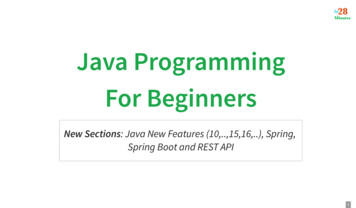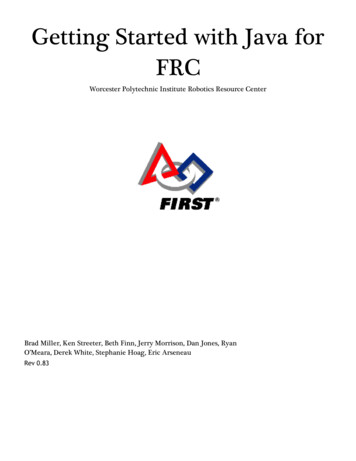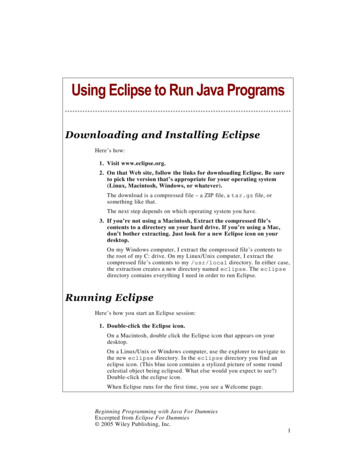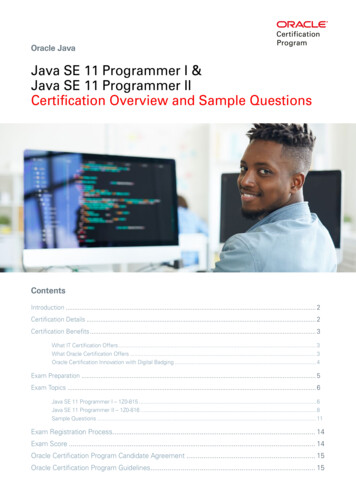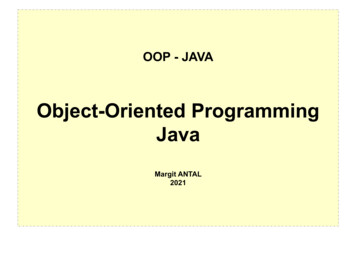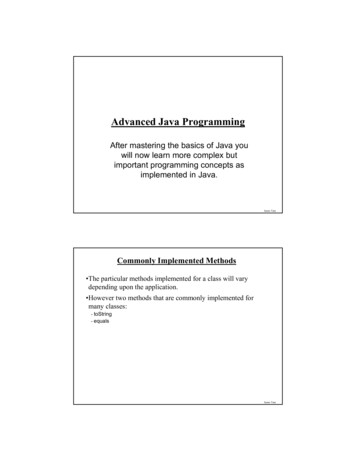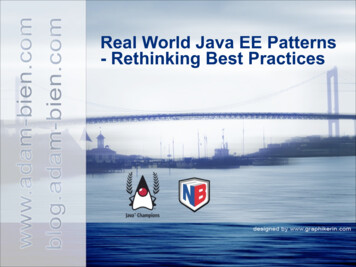
Transcription
Real World Java EE Patterns- Rethinking Best Practicesblog.adam-bien.com
IntroductionExpert Group Member (jcp.org) of Java EE 6, EJB 3.1, Time and Date and JPA 2.0Java Champion,Netbeans Dream Team Member, (JavaONE) speaker, freelancer,consultant and author: 7 German books working on “Real World Java EEPatterns– Rethinking Best Practices” http://press.adam-bien.comTrainer, Developer and Architect (since JDK 1.0)Project owner/committer: greenfire.dev.java.net, ien.com
Based on:blog.adam-bien.com
1. EJBs Are Heavyweightblog.adam-bien.com
EJBs Are HeavyweightConfiguration is mainly gone, because of conventions.(there was no XML in my last projects exceptpersistence.xml)EJB 3 are just annotated Java classes (if you love XMLyou can even use just Deployment Descriptors instead ofannotation)Container “services” like transactions, security,concurrency or state are implemented with aspects (oftenrealized with dynamic proxies)blog.adam-bien.com
EJBs Are Heavyweight"POJOs" are just JavaBeans maintained by anothercontainer, using similar techniques as EJB 3.1EJB 3 containers are surprisingly small. Glassfish v3 EAcomes with two jars (688kB 8kB 796kB). The EJB 3container is an OSGI bundle.The whole EJB 3.1 API is about 47 kB.blog.adam-bien.com
2. EJBs Are Not Portableblog.adam-bien.com
EJBs Are Not PortableJ2EE 1.4 was underspecified :-) - EJB 3.X / JPA specscover more real world stuff (locking, optimisticconcurrency etc.).Vendor specific deployment descriptor were painful formigration - they are basically gone.In most cases a EJB-JAR module is nothing but a JARwithout any XML descriptors (neither ejb-jar.xml norvendor specific)Vendor specific annotations are not needed to develop aJava EE application.There is NOTHING vendor specific in an EAR. Theportability is really good.blog.adam-bien.com
3. EJBs Are Not Extensibleblog.adam-bien.com
EJBs Are Not ExtensibleHow to inject a Guice component into an EJB 3:blog.adam-bien.com
EJBs Are Not ExtensibleThe Guice (fluent) configuration:blog.adam-bien.com
EJBs Are Not ExtensibleYou only need an interceptor:blog.adam-bien.com
EJBs Are Not ExtensibleInterceptors are able to access the Bean instance directly.Having an instance available - you can manipulate it;inject members use reflection to invoke methods, or setfields.It is very interesting for the integration of existing “legacy”IoC frameworks :-)blog.adam-bien.com
4. EJBs Are Slowblog.adam-bien.com
EJBs Are SlowThe throughput of the EJB 3 solution was 2391transactions/second. The slowest method call took 7milliseconds. The average wasn't measurable. Pleasekeep in mind that in every request two session beanswere involved - so the overhead is doubled.POJO: The throughput of the POJO solution was 2562requests/second (request - there are no transactionshere). The slowest method call took 10 ms.The difference is 171 requests / seconds, or 6.6%blog.adam-bien.com
5. EJBs Are Too Complexblog.adam-bien.com
EJBs Are Too ComplexJava EE is distributed and concurrent platform perdefinition.It mainly abstracts already existing products (messaging,EIS, relational databases)Distributed programming with shared state is always achallenge.In the Cloud Computing / SOA era non-functionalrequirements like: monitoring (JMX), management, failover or elasticity become more and more important.Think about the ratio between the essential andaccidential complexity.blog.adam-bien.com
6. EJBs Are Hard To Developblog.adam-bien.com
EJBs Are Hard To DevelopSimplest possible EJB 3.1:@Statelesspublic class SimpleSample{public void doSomething() { /*business logic*/ }}blog.adam-bien.com
EJBs Are Hard To DevelopHow to compile:You will need the the EJB 3.0 / 3.1 API in the classpath, or at least the@Stateless annotation.How to deploy:Just JAR the class and put the JAR into e.g: \autodeployHow to use:import javax.ejb.EJB;public class MyServlet extends HttpServlet{@EJBprivate SimpleSample sample;}blog.adam-bien.com
Agile Manifestoblog.adam-bien.com
Agile Manifesto in Java EE ContextWe are uncovering better ways of developing software by doing it andhelping others do it. Through this work we have come to value:Individuals and interactions over processes and toolsWorking software over comprehensive documentationCustomer collaboration over contract negotiationResponding to change over following a plan[Pragmatic solutions over infinite layers indirections,frameworks and patterns] (decorated by Adam Bien)That is, while there is value in the items on the right, wevalue the items on the left more.blog.adam-bien.com
Entity Control Boundaryblog.adam-bien.com
Entity Control BoundaryThe “lightweight” way to design applications:Entity: persistent object (“domain objects” fromconceptual model)Control: process knowledge - entity independentlogic, the glue between the boundary and theentityBoundary: the interface between the actor andthe use caseblog.adam-bien.com
SOA Architectureblog.adam-bien.com
SOA Architectureblog.adam-bien.com
Service Facadeblog.adam-bien.com
Service Facade (Context)“In the J2EE era Session Facades were just wrappers ofEntity Beans or DAOs. They were motivated rather by theshortcoming of the spec, than by design best practices.The technical nature of the Session Façade was thereason for their thin logic. Application Service was the usecase controller or façade, which coordinated multipleSession Facades. The landscape, however, changed inJava EE. “blog.adam-bien.com
Service FacadeIn Java EE an explicit remote and transactional boundaryis still needed. The exposure of fine grained businesslogic over remote interfaces simply doesn’t work.Network latency is too high for fine grained access and itis hard to execute fine grained methods in a transactioncontext over the network.blog.adam-bien.com
Service Facade (Solution)Service Façade is a Stateless, in exceptional casesStateful Session Bean with a local business interface.A remote business interface should be only provided if itis going to be used from outside the JVM and not injectedinto Servlet, Backing Bean or other web component.An Eclipse or Netbeans RCP (Rich Client Platform)application would be one example for that.blog.adam-bien.com
Service Facadeblog.adam-bien.com
Service Facade (Conventions)Service Façade resides in a component which is realizedas Java-package with domain-specific name e.g.ordermgmt.The realization of the façade (business interface and thebean implementation) resides in a sub-package with thename facade e.g. ordermgmt.facade. This makes theautomatic verification of the architecture easier.The business interface is named after business concepts,without the obligatory local or remote suffix e.g.OrderService and OrderServiceBean.blog.adam-bien.com
Dual View Service Facadeblog.adam-bien.com
Serviceblog.adam-bien.com
Service (Context)The origin context of a Session Facade (SF) was definedin the Core J2EE pattern as following:“Enterprise beans encapsulate business logic andbusiness data and expose their interfaces, and thus thecomplexity of the distributed services, to the client tier.”- tterns/SessionFacade.htmlblog.adam-bien.com
Service (Context)The context changed in Java EE quite a bit: A Service is a procedural activity. It realizes activities or sub processes. In an object oriented, domain driven context, a Servicerealizes cross cutting, domain object independent logic. In a SOA a Service plays the main role and implementsthe actual business logic.blog.adam-bien.com
Service (Forces)Services should be independent of each other.The granularity of a Service is finer than of a Service Façade.The Services are not accessible and even visible fromoutside the business tier.A Service should be not accessible from an external JVM. Aremote Service invocation doesn’t make sense and should beavoided.A Service is aimed to be reused from other component orService Façade.The execution of a Service should be always consistent. Itsmethods should either have no side effects (be idempotent),or be able to be invoked in a transactional context.blog.adam-bien.com
Service (Solution)A Service is always local and comes with theTransactionAttributeType.MANDATORY teType.MANDATORY)public class DeliveryServiceBean implements DeliveryService {}blog.adam-bien.com
Service (Conventions)A Service is a local, stateless session bean.Service resides in a component which is realized as Javapackage with domain-specific name e.g. ordermgmt.The realization of the service (business interface and thebean implementation) resides in a sub-package with thename “service” e.g. ordermgmt.service. This makes theautomatic verification of the architecture easier.The business interface is named after business concepts,without the obligatory local or remote suffix e.g.OrderService and OrderServiceBean.blog.adam-bien.com
Service (Conventions)It is not required to use the term “Service” in the name ofthe bean – its redundant. For identification purposes youcould use a @Service annotation.The Service is always invoked in the context of anexisting transaction. It is deployed with the Mandatorytransaction attribute.blog.adam-bien.com
Domain Driven DesignSeite
Domain Driven DesignDomain-driven design (DDD) is an approach to thedesign of software, based on the two premises thatcomplex domain designs should be based on a model,and that, for most software projects, the primary focusshould be on the domain and domain logic (as opposedto being the particular technology used to implement thesystem).blog.adam-bien.com
Domain Driven DesignThe idea:The domain model should form a common language given bydomain experts for describing system requirements, that worksequally well for the business users or sponsors and for the softwaredevelopers.blog.adam-bien.com
Domain Driven Architectureblog.adam-bien.com
DD Architectureblog.adam-bien.com
Persistent Domain Objectblog.adam-bien.com
Persistent Domain Object (Context)The origin problem description in J2EE Core Patternswas short and sound: “You have a conceptual domainmodel with business logic and relationship.” nessObject.htmEven in the origin description of the Business ObjectJ2EE Pattern the realization of the conceptual model withprocedural approaches was considered as dangerousregarding to bloating, code duplication spread overdifferent modules and therefore hard to maintain.blog.adam-bien.com
Persistent Domain Object (Problem)The vast majority of J2EE applications were build in theprocedural way.The business logic was decomposed into tasks andresources, which were mapped into Services and anemic,persistent entities.The procedural approach works surprisingly well untiltype specific behavior for domain objects has to berealized.blog.adam-bien.com
Persistent Domain Object (Problem)The attempt to realize object oriented algorithms withprocedural techniques ends up in many instanceofchecks and / or lengthy if-statements.Such type checks are required, because the domainobjects are anemic in the procedural world, so thatinheritance doesn't really pays off.Even in case inheritance was used for designing thedomain model, the most powerful feature – polymorphicbehavior –– and so in Services or Service Facades.blog.adam-bien.com
Persistent Domain Object (Forces)Your business logic is complex.The validation rules are domain object related andsophisticated.The conceptual model can be derived from the requirementsand mapped to domain objects.The domain objects have to be persisted in relationaldatabase (it’s the common case).The Use Cases, User Stories or other specificationdocuments already describe the target domain in objectoriented way. The relation between the behavior and thedata can be directly derived from the specification.blog.adam-bien.com
Persistent Domain Object (Forces)It is a green field project, or at least the existing databasewas designed in way that allows the use of JPA. It means:the tables and columns are reasonable named and thedatabase is not overly normalized.blog.adam-bien.com
Persistent Domain Object - sampleblog.adam-bien.com
Persistent Domain Object - procedural type checks.int computeShippingCost(Load load){int shippingCosts 0;int weight 0;int defaultCost 0;for (OrderItem orderItem : load.getOrderItems()) {LoadType loadType orderItem.getLoadType();weight orderItem.getWeight();defaultCost weight * 5;switch (loadType) {case BULKY:shippingCosts (defaultCost 5);break;case LIGHTWEIGHT:shippingCosts (defaultCost - 1);break;case STANDARD:shippingCosts (defaultCost);break;default:throw new IllegalStateException("Unknown type: " loadType);}}return shippingCosts;}blog.adam-bien.com
Type checks - the object oriented waypublic int getShippingCosts() {int shippingCosts 0;for (OrderItem orderItem : orderItems) {shippingCosts orderItem.getShippingCost();}return shippingCosts;}blog.adam-bien.com
Inheritance does the workpublic class BulkyItem extends OrderItem{public BulkyItem(int weight) {super(weight);}@Overridepublic int getShippingCost() {return super.getShippingCost() 5;}}blog.adam-bien.com
The procedural constructionLoad load new Load();OrderItem standard new tandard);OrderItem light new t);OrderItem bulky new g.adam-bien.com
.and the fluent wayLoad build new m
Persistent Domain Object (Conventions)PDOs are JPA entities with emphasis to domain logic andnot the technology.PDO resides in a component which is realized as Javapackage with domain-specific name e.g. ordermgmt.The PDO resides in a sub-package (layer) with the namedomainordermgmt.domain. This makes the automaticverification of the architecture easier.The name of the domain object is derived from the targetdomain.Getters and setters are not obligatory – they should beonly used in justified cases.blog.adam-bien.com
Gatewayblog.adam-bien.com
Gateway (Context)PDOs are already consistent, encapsulated objects withhidden state. There is no need for further encapsulation –they can be directly exposed to the presentation.A Gateway provides an entry point to the root PDOs.A Gateway could be even considered as an anti-ServiceFaçade – in fact its responsibilities are inverted.blog.adam-bien.com
Gateway (Problem)PDOs are passive artifacts.It is not possible to access them directly without anexecution context.The next problem is the stateless nature of most Java EEapplications.After a method invocation of a transaction boundary (e.g.a Stateless Session Bean) all JPA-entities (PDOs)become detached. The client loses its state.blog.adam-bien.com
Gateway (Problem)This forces you to transport the whole context back andforth between the client and the server, which leads to thefollowing problems:Heavily interconnected PDOs become hard to merge.Even for fine grained changes, the whole graph of objects has to betransported back to server.It is not always possible to merge the graph automatically and evenconsistently.blog.adam-bien.com
Gateway (Solution)The solution is very simple. Just create a perfect “AntiService Façade”.Instead of cleanly encapsulating the PDOs, just try to asconveniently for the UI as possible expose PDOs to theadjacent layer.Allow the user to modify the PDOs directly without anyindirection.The described approach above actually contradicts thecommon J2EE principles, where encapsulation seemedto be the only way to achieve maintainability. This is onlytrue for perfect abstractions and encapsulations, whichare very hard to find in real world projects.blog.adam-bien.com
Gateway (Solution)The inverse strategy works even better for some UseCases – just get rid of any layer which is probably leakyanyway and expose the business logic directly to thepresentation tier.Every change in the structure of the persistence layerwould be immediately visible in the UI – this makes theimplementation of feature requests really easy.blog.adam-bien.com
Gateway (Solution)Your presentation is coupled to the particularimplementation of the business logic, but the concreteimplementation is already encapsulated.JPA abstracts from the particular provider, and EJBs arenothing else than annotated POJOs.The concrete state and implementation of domain specificlogic is well encapsulated too – it’s the main responsibilityof the PDOs.blog.adam-bien.com
Gateway - the solution again.The solution for the problem is the introduction of state onthe server side.A stateful Gateway can keep the PDOs attached with anEntityManager declared asPersistenceContext.EXTENDED.The EntityManager needs a transaction only as atrigger to flush the changes to the database, which can bestarted by a method which overrides the class default.blog.adam-bien.com
Gateway - sample:blog.adam-bien.com
Gateway (Conventions)A Gateway resides in a component which is realized asJava-package with domain-specific name e.g. ordermgmt.The Gateway resides in a sub-package (layer) with thename “facade” e.g. ordermgmt.facade. This makes theautomatic verification of the architecture easier. TheGateway resides therefore in the same sub-package as aService Façade.A Gateway is often named after the cached root entity – itis not necessary to keep the name “Gateway”.blog.adam-bien.com
Thank you!blog.adam-bien.com
Interested in „highend“ trainings, coaching, consulting? just send me an email abien@adam-bien.comblog.adam-bien.com
Domain Driven Design Domain-driven design (DDD) is an approach to the design of software, based on the two premises that complex domain designs should be based on a model, and that, for most software projects, the primary focus should be on the domain and domain logic (as opposed to being



